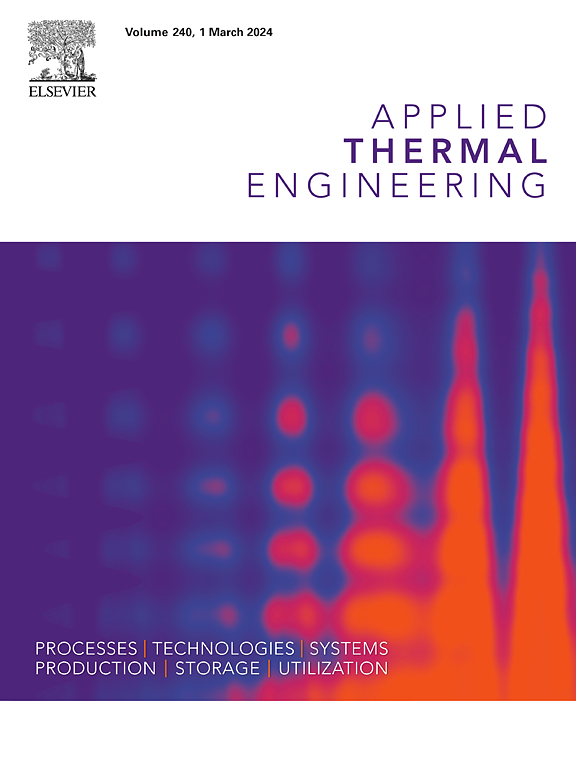Study on the inhibition effect of dual-frequency ultrasonic on CaCO3 fouling in heat exchanger tubes
IF 6.9
2区 工程技术
Q2 ENERGY & FUELS
引用次数: 0
Abstract
At present, heat exchangers are widely used in industrial production processes, but fouling will lead to an increase in their energy consumption, and the application of ultrasonic can effectively reduce fouling. This study presents a crystallization fouling model under the action of ultrasonic, aimed at investigating the inhibitory effect of dual-frequency ultrasonic on CaCO3 fouling in heat exchanger tubes. Based on the constructed model, this study primarily compares the effects of single-frequency and dual-frequency ultrasonic, with a detailed analysis of the impact of pressure amplitude and frequency of the dual-frequency ultrasonic. The results indicate that dual-frequency ultrasonic at 20 + 40 kHz exhibits the fouling inhibition rate 19.9 % and 36.2 % higher than single-frequency ultrasonic at 20 kHz and 40 kHz, respectively. The fouling layer thickness under ultrasonic action increases progressively with tube length, while the wall shear force varies periodically over time. The average of wall shear force under dual-frequency ultrasonic action is higher than that under single-frequency. In the research range of dual-frequency ultrasonic, increasing pressure amplitude enhances its fouling inhibition effect. As pressure amplitude increases from 100 kPa to 250 kPa, the fouling inhibition rate rises by 21 %. An increase in frequency weakens the fouling inhibition effect. When the co-frequency increases from 30 + 30 kHz to 60 + 60 kHz, the fouling inhibition rate decreases by 19.9 %. When the different-frequency increased from 20 + 40 kHz to 50 + 70 kHz, the fouling inhibition rate decreased by 24.1 %. Additionally, the fouling inhibition rate at different-frequency ultrasonic is consistently higher than that at the co-frequency, indicating that different-frequency ultrasonic provides better inhibition. Furthermore, the fouling layer thickness decreases with increasing pressure amplitude and increases with frequency.
双频超声对换热器管内CaCO3污垢抑制效果的研究
目前,热交换器在工业生产过程中得到了广泛的应用,但结垢会导致其能耗的增加,而超声波的应用可以有效地减少结垢。本研究建立了超声作用下的结晶结垢模型,旨在研究双频超声对换热器管内CaCO3结垢的抑制作用。在构建的模型基础上,本研究主要对比了单频和双频超声的作用效果,并详细分析了双频超声压力幅值和频率的影响。结果表明:20 + 40 kHz时,双频超声对污垢的抑制率分别比20 kHz和40 kHz时的单频超声高19.9%和36.2%;超声作用下污垢层厚度随管道长度逐渐增加,而管壁剪切力随时间周期性变化。双频超声作用下墙体剪力的平均值高于单频超声作用下的平均值。在双频超声研究范围内,增大压力幅值可增强其阻垢效果。当压力幅值从100 kPa增加到250 kPa时,阻垢率提高21%。频率增加,阻垢效果减弱。当共频从30 + 30 kHz增加到60 + 60 kHz时,阻垢率降低了19.9%。当不同频率从20 + 40 kHz增加到50 + 70 kHz时,污垢抑制率降低了24.1%。此外,不同频率的超声波对污垢的抑制率始终高于同频率,表明不同频率的超声波对污垢的抑制效果更好。污垢层厚度随压力幅值的增加而减小,随频率的增加而增大。
本文章由计算机程序翻译,如有差异,请以英文原文为准。
求助全文
约1分钟内获得全文
求助全文
来源期刊

Applied Thermal Engineering
工程技术-工程:机械
CiteScore
11.30
自引率
15.60%
发文量
1474
审稿时长
57 days
期刊介绍:
Applied Thermal Engineering disseminates novel research related to the design, development and demonstration of components, devices, equipment, technologies and systems involving thermal processes for the production, storage, utilization and conservation of energy, with a focus on engineering application.
The journal publishes high-quality and high-impact Original Research Articles, Review Articles, Short Communications and Letters to the Editor on cutting-edge innovations in research, and recent advances or issues of interest to the thermal engineering community.
 求助内容:
求助内容: 应助结果提醒方式:
应助结果提醒方式:


